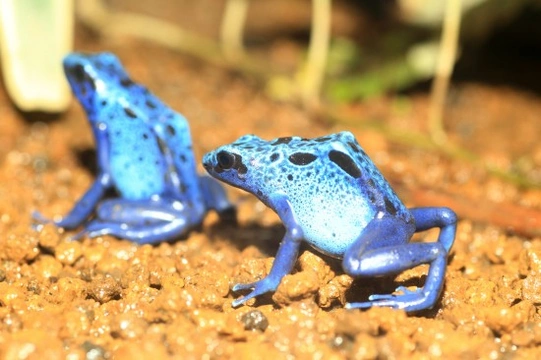
Poison Dart Frogs
One of the brightest and most vibrant amphibians Poison Dart Frogs range in size from about 1 cm to 7cm in body length. There are over 100 species of Poison Dart Frogs and their behaviours and ecological niches are as varied as their colours. Of these only 3 are dangerous to humans, with the Golden Poison Arrow frog (Phyllobates terribilis) being the most toxic.
Numerous creatures have evolved bright patterns and colours to warn predators that they are venomous or poisonous, and Dart Frog are no exception. Their bright colours keep them safe from all the predators other than humans and is so successful that other non-poisonous frogs have evolved similar patterns and colours to take advantage of this fact.
Their name comes from the poison on their skin. Originally the Amerindian tribes who lived and hunted in the Amazon rain forest would rub the tips of their arrows across the frog’s skin to gather the poison on their darts for hunting. They would shoot monkeys and other game in the tree tops, although it was normally the fall that killed the prey rather than the toxin.
Found across the rainforests of Central and South America, and a few Hawaiian Islands, to keep these tiny frog healthy they need a habitat that mimics these conditions.
Setting up a Terrarium
There are numerous readymade terrariums that you can buy, but a 60cm tank can also make a great habitat.
Step 1. Place either a bulkhead fitting or a siphon so that you can later drain off excess water.
Step 2. Place a drainage layer in the bottom LECA (Lightweight Expanded Clay Aggregate) is the ideal drainage layer, or aquarium gravel can be used. This allows the extra water to be collected, before being drained of syphoned off.
Step 3. Lay a substrate barrier across the drainage layer. A few layers of landscaping fabric seems to be one of the better options, or fiberglass screening, just make sure that anything you use can be in a wet environment for a few years without rotting.
Step 4. Add the growing media. This is the layer in which your plants will grow. A good mix is sphagnum peat moss and coco fibre. 3-4 cm of substrate should be plenty.
Step 5. Add your plants. Small species of bromeliad and other plants that would naturally grow in Central and South America and will withstand the high humidity these little guys enjoy.
Step 6. Add the furnishings, these should include a water dish, climbing branches and a hide.
Step 7. Add micro fauna, these are the little critters that will run round, keep everything healthy and provide a natural environment, these can include isopods and springtails.
Step 8. Install a fruit fly proof lid. As their main food source it’s important that the fruit flies stay inside the terrarium with the frog. A well-fitting glass lid is the ideal solution, but it’s advisable to have the edges rounded so you don’t cut yourself.
Step 9. Add the lighting, the lighting should encourage plant growth.
Step 10. Mist well and add the frogs. This size of terrarium is suitable for a pair of smaller frogs.
It is important to keep both the humidity and temperature up in the terrarium. Under tank heating is one of the better solutions and daily misting will keep the humidity up.
Feeding
Dart Frogs have small tongues that are long and sticky. Fruit flies are one of the best foods for these little guys and are the staple for many keepers, bean weevils, springtails, isopods, subterranean termites and pinhead crickets are all good foods. Aim to feed a variety of good quality foods and gut load them before offering them to the frogs.
Breeding
Some species of frogs have been bred in captivity for decades now, whilst others are still being caught in the wild. By breeding in captivity the hobbyist does two things. One they reduce the numbers of frogs that are taken from the wild, and two assuming that the frogs they breed are healthy and not hybrids, they expand the available gene pool in captivity.
As with most frogs the males will call for a female, the females respond by laying eggs on leaves or other sites. The males will fertilize the eggs, which hopefully will hatch within 12-14 days. The male will carry the tadpoles to the water, where for most of the species this is the end of their parenting duties. Some will return to feed the tadpoles, sometimes with unfertilized eggs.
Part of raising the tadpoles is ensuring that the water quality is as close to perfect as possible, tadpoles can be cannibalistic so most species will have to be housed singly.
Purchasing Frogs
Some specialist reptile shops will either have some of the more common species in, or will be able to order some in for you. It’s worth joining a club or society, either on line, or a local group, not only will they be able to help you source frogs, but they can also offer advice, feeding cultures and source equipment.
Why do Dart Frogs make great pets?
So after talking about how they’re brightly coloured because they’re poisonous in fact in captivity they’re completely safe, their toxin comes from their diet in the wild. They’re small and don’t take up a lot of space, they don’t cost a lot to feed and are relatively easy to keep. You don’t need to clean out massive amounts of pooh, and they are generally active in the day.
Added to this that you can make their enclosures look stunning and attractive, a real slice of Amazonian jungle in your house and you have an almost perfect pet.



